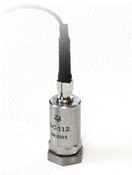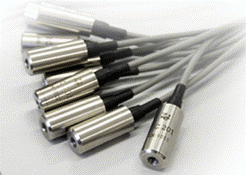Methods for the calibration of accelerometers
The accuracy, reliability and versatility of accelerometers lose their values in the event it is impossible to provide traceable results of mechanical oscillations researches, carried out with the help of accelerometer, with absolute standards of units of the corresponding physical quantities. The purpose of calibration is to provide such connection and hence give sense to the parameters used in the equipment and to maintain the desired confidence level of results, obtained by using this equipment. As a result of testing and verification, we obtain data that contribute to environment conditions and a range in which calibration results are valid and, therefore, above-mentioned connection to accounted standards is ensured and maintained.
Accelerometers of our company are subjected to detailed testing, inspection and quality control, the aim of which is to ensure the necessary reliability, stability and the small spread of parameters. Some accelerometers are individually calibrated and supplied with data sheets containing the relevant technical data.
The term “calibration” is often indicated only by a determination of the sensitivity of the accelerometer. However, this term is wider, and in accelerometer data sheet, which contains calibration results, also provides its frequency response, capacitance and weight values, parameters related to environmental conditions, etc.
The main purpose of the calibration of accelerometers is to provide the connection of results of explorations of mechanical vibrations, which are made with their help, with absolute standard units of the corresponding physical quantities and hence to ensure a certain degree of accuracy, repeatability and reliability. However, next to the main goal, accelerometer calibration is often carried out by legislative or contractual reasons, which require certification with indicating the accuracy of accelerometers in accordance with international standards and recommendations.
In practical use of accelerometers, situations in which these data in the respective data sheets do not overlap the actual operating conditions of the vibration sensors in certain systems or environments are not excluded. In such situations, it is necessary to carry out a special calibration, which complies with the terms of operating conditions and application of the accelerometers. We note that data sheets of accelerometers, which are made by our company, contain data that are right in most applications.
Testing of the equipment and systems that contains the accelerometers is an important part of calibration process. This applies in particular to complex systems involving many instruments and devices. Errors related to the incorrect definition of system’s overall sensitivity, gain, etc. can be quickly eliminated by a quick check. Principles and methods of such check are discussed in the article “Checking the accelerometers and associated instrumentation using calibrators”.
 Before the accelerometer calibration, it is advisable to measure its frequency response.
Before the accelerometer calibration, it is advisable to measure its frequency response.
On the basis of this characteristic, it can be determined whether the accelerometer is calibrated in a safe condition.
Irregularity of AFC curve indicates the precarious state of the accelerometer, limit of its operating frequency range or even its failure.
In this situation, the accelerometer calibration doesn’t make sense, because its results are not valid.
Methods used in calibration, that is carried out in order to determine the sensitivity of the accelerometer, can be divided into the following groups:
-
- Absolute methods, which include the method based on the use of a laser displacement sensor, a method of reciprocity and other methods.
-
- Comparison methods, which include the method of comparison with accelerometers, which are mechanically linked to each other.
-
- Methods based on the use of calibrators, such as shakers or vibrators, with precisely defined parameters (in particular, the parameters of mechanical vibrations of the vibrating table, etc.)
The most common method is the comparison with exemplary sensor.
